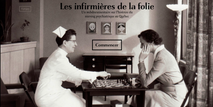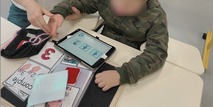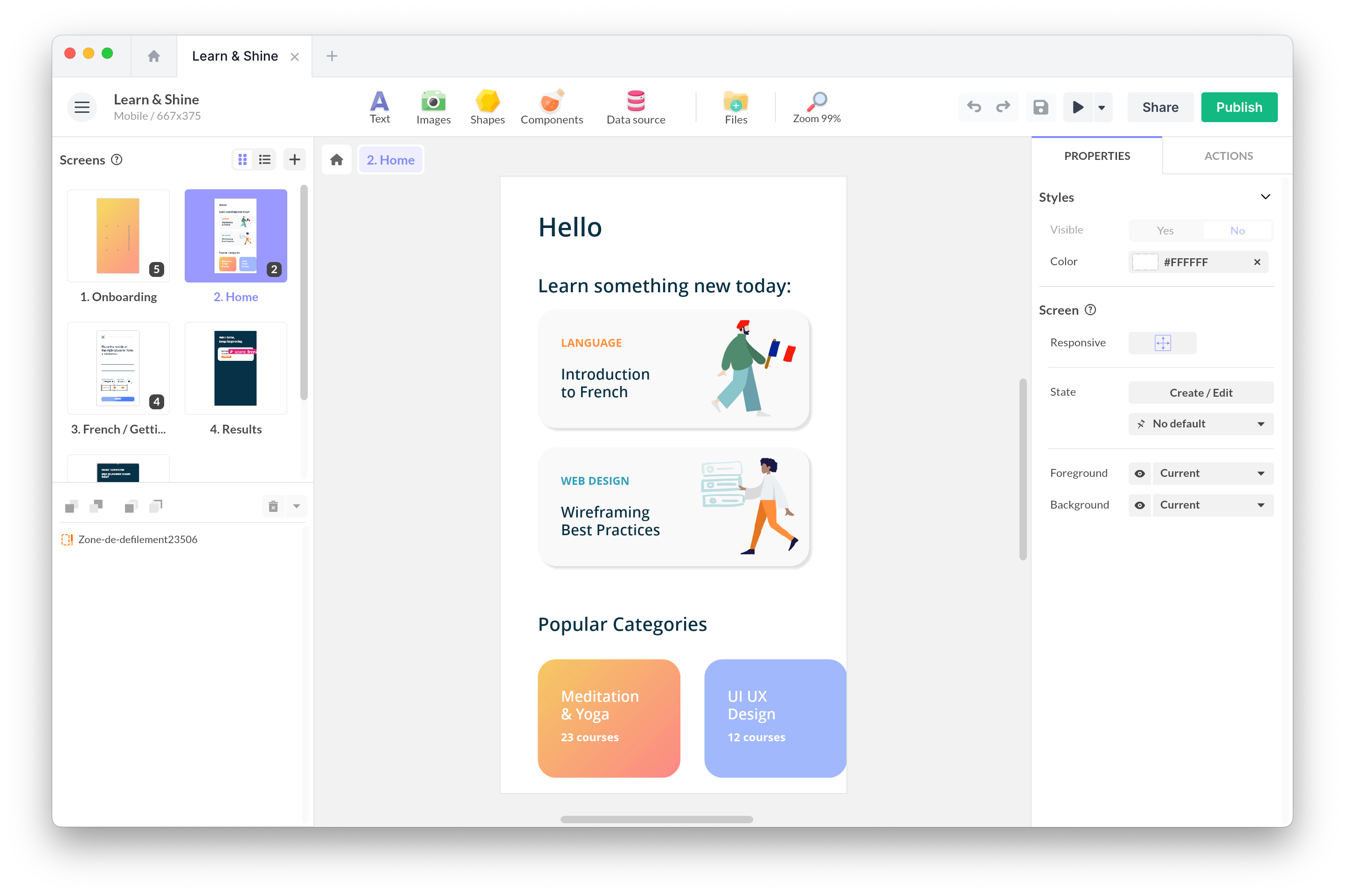Wed, Mar 7, 2018
The Secrets of The Award-Winning Digital Comic Book
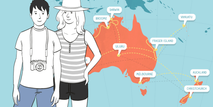
When Sophie Taboni mentioned us this project for the first time, we were early 2017, and she was writing us from Australia. One year later, she and Nicolas Catherin received the Digital Challenge Award for Angoulême International Comics Festival for “Ici tout va bien” animated comics. Today she tells us more about this project and shares with us some of their sources if inspiration by Skype.
The animated comics? After a short hesitation, Sophie confesses they chose this format because it was the perfect match between her taste for storytelling and drawing and Nicolas’ taste for beautiful pictures.
From Angoulême International Comics Festival, they remember discovering new artists, attending captivating exhibitions, meetings with passionate people, but also they faced a hesitating professional world that is still looking for profitability: “Digital comics offer a lot of new possibilities on the narrative side, but for the moment there is no real business model. You really have to provide a personal investment, except for projects like Phallaina supported by France TV. Or with public channels like the digital creation help of the CNC.”
How it started
The project "Ici tout va bien" came to life during their trip to Australia and New Zealand, it’s an interactive story available on the web and for tablets (iOS, Android).
First they were looking for an original way to share their road trip to their family and friends. Both of them like to do things differently. Before they leave, they built an interactive resume in a few days with an integrator friend’s help: “We like to add storytelling in things we do. In this resume, there was not many interactions but there was something interactive and fun. The project had a great success!”
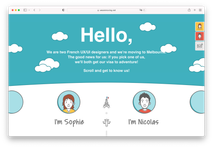
They had to choose which format they wanted for their travel story: would it be a fiction? An investigation? “We wanted to frame the story beforehand, but in the end we said to ourselves that it would be difficult to anticipate what we were going to live and that we would not have enough time to develop a really constructed story. We decided to let the journey brings us and to improvise. One of the original ideas was to write the story from two angles to create a comic effect: the epic, fantasy angle of the trip and the trivial, real life angle (e.g. tourism with 15,000 people taking the same beautiful picture as you). People could have switched from one to the other. But even that would have been too constraining.”
No worries, they agree on other principles: the horizontal scroll, the mix of photo and drawing and an artistic direction they decide beforehand. They choose to remain free for everything else.
They complete the chapter on Melbourne before their departure. This is what allows them to determine the graphic design.
On the road, the roles are well defined: Sophie makes the first sketches, the storyboard and draw on her tablet. Nicolas takes the pictures, rearranges the layout and makes the vector illustrations at the beginning of each chapter. "The project gave a different flavor to the trip. We said to ourselves, 'Here, go ahead, take this picture, it might work well. We were looking for textures (sand...) and angles of view, paths for example, allowing us to “blend” in with the scenery.”
From a narrative point of view, they always try to renew themselves in order not to be too boring and "travel book". So they decide to take the point of view of a mosquito in New Zealand, to approach Uluru from a cultural point of view and to create a fictional story for Broome.
Did all the anecdotes really happen? Sophie admits to some adjustments: "When we returned to Australia, the plane turned around. In the story I fall asleep but in reality I was wide awake! I sometimes changed small details, otherwise it's not fun."
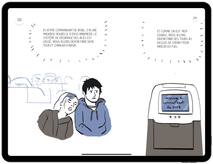
The stories are born from the little jokes they make with each other. And sometimes reality exceeds fiction: "The story of the flies in the caves is told in a rather trashy way. And it really happened like that. The guide asked us: "Do you want to keep the magic or do you want the real story? ' He was super funny so I hardly had to change anything.”
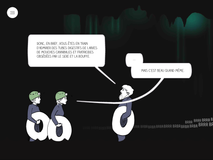
Simple and impactful
Sophie has long had a taste for beautiful stories. And it is especially in digital storytelling that she flourishes because she admits to having "more ideas in animated and sequential images than in still images".
From her first project, in 2009, she had a lot of fun playing with interactivity. "I had filmed my roommate and called it 'Tête de Turc'. It was a story with twists and turns and you could take your anger out on him, interact with the video, throw tomatoes at him, send him glasses of water, play with the elements embedded in the set." All done in Flash at the time.
Sophie likes autobiographical stories, reports, new ideas coming out in digital storytelling. Upian and Benjamin Hoguet's blog are some of sources of inspiration.
She found Bury me my love, the story in the form of a Whatsapp thread of a Syrian woman who leaves for France, "hyper moving and immersive". It is the user who through a series of choices guides her trajectory and destiny. She also appreciated the story of Alma, the drug trafficker in Mexico, "whose upper body and face you only see throughout the web documentary. Without wanting to spoil you, at the end you are surprised".
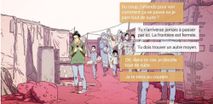
Keeping it simple and impactful is what they believe is the recipe for the best stories. Avoiding the gimmicky effect and making sure that the format really serves the contnt of the story.
Today, while Nicolas devotes himself to his new hobby, carpentry, and works in a service design agency to make people's lives simpler, Sophie has given herself a year to deepen her drawing skills, alongside her freelance activity. For her, drawing "is a crazy freedom". She says it is a "super power that will allow her to tell everything by herself, without material constraints". "The circle is coming full circle, all my interests are coming together to end up with digital stories, with drawing and with the "real", whether it's reportage or self-fiction."
The power to finish
"Finished but not perfect." They hold this phrase from YouTuber Jake Parker as a mantra and encourage everyone to do personal projects. And to see it through to the end. "That video we were thinking about the whole time. Okay, we're perfectionists but this project, we have to finish it. There is nothing more gratifying than putting a final touch to a personal work. Even if it's not perfect. When I look at "Tête de turc" today, I say to myself that it is rather ugly, I have a smile on my face, but it served me. There's not a single personal project we've done that didn't benefit us in some way or another."
The online resume made in 2 weeks helped them land their jobs in Australia, among other things.
The Angoulême prize was the "cherry on the cake", but what they remember most is the feedback from people. "At the beginning, we said to ourselves, it will be for our family and friends (and even for the family, I said to myself "my grandfather, there are things that won't make him laugh at all"). But in the end it reached a wider audience than we thought, and of all ages. That's the most unexpected and cool thing about this project."
Discover their story online: http://www.icitoutvabien.net
Or download the app from the App Store and Google Play
